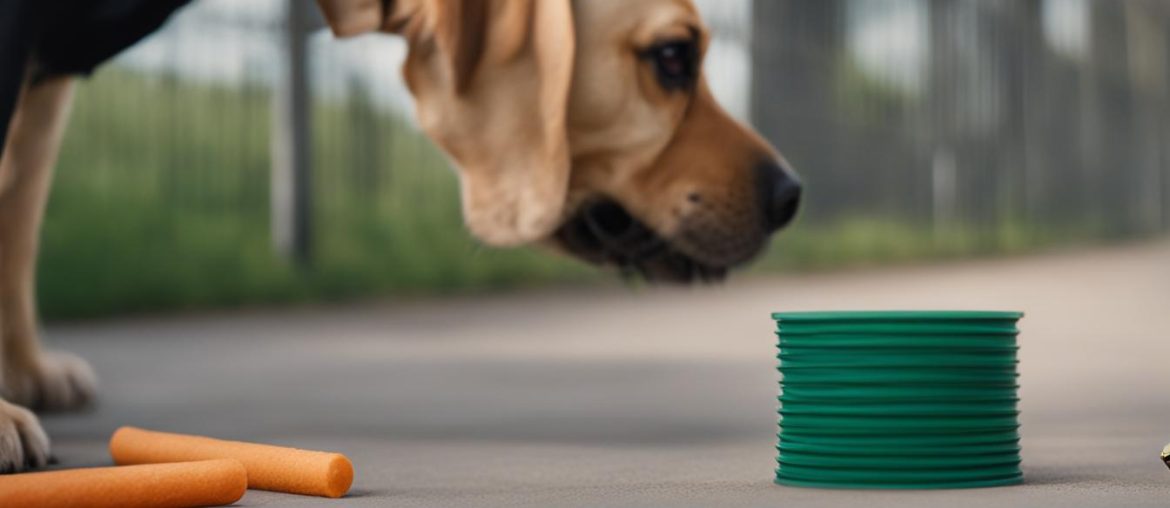Nose targeting, also known as “Touch,” is a valuable skill for training dogs. It involves teaching your dog to touch a target with their nose, which can be used for various training purposes. This article will provide a step-by-step guide on how to teach your dog nose touch, including training techniques and the benefits of nose touch training.
Key Takeaways:
- Nose touch training is a valuable skill for dogs.
- Teaching your dog nose touch involves using a target object.
- Start with your hand as the target and gradually introduce different objects.
- Use positive reinforcement techniques and rewards to encourage your dog’s progress.
- Nose touch training can be applied to obedience training, trick training, and helping anxious or reactive dogs.
The Basics of Nose Touch Training
Nose touch training, also known as nose targeting or touch training, is a fundamental skill that can be taught to dogs of all ages and breeds. This training technique involves teaching your dog to touch a target, usually your hand or an object, with their nose. It is a versatile behavior that can be used in various contexts, including obedience training, trick training, and behavior modification for anxious or reactive dogs.
To start nose touch training, begin by holding your flat hand a few inches away from your dog’s nose. When their nose makes contact with your hand, use a clicker or a marker word (such as “Yes!”) to signal that they have done the correct behavior. Repeat this process until your dog consistently touches your hand with their nose. This will establish the foundation for the nose touch command.
Once your dog is reliably touching your hand, you can introduce a verbal cue like “Touch” or “Nose.” Say the cue right before presenting your hand as the target, so your dog starts associating the command with the behavior. Gradually increase the distance between your hand and your dog’s nose, and start introducing distractions to make the training more challenging. You can also start using different objects, such as a yogurt lid or a piece of clear plastic, as targets to generalize the behavior.
Nose touch training is an effective way to enhance communication and cooperation between you and your dog. It provides mental stimulation and helps dogs focus their attention on a specific task. Whether you want to teach your dog basic obedience commands, impressive tricks, or help them overcome anxiety or reactivity, nose touch training can be a valuable tool in achieving these goals.
Tips for Successful Nose Touch Training
When it comes to teaching your dog nose touch, there are several effective methods that can help ensure success. By following these training techniques, you can strengthen your dog’s nose targeting abilities and enhance their overall training experience.
Use high-value treats and praise
To make nose touch training more enticing for your dog, use treats that they find especially exciting. Whether it’s small pieces of cooked chicken, freeze-dried liver, or their favorite store-bought treats, find something that motivates them to engage in the behavior. Alongside treats, provide plenty of verbal praise and positive reinforcement to further reinforce the desired behavior.
Shape the behavior gradually
Dogs learn best when behaviors are shaped gradually. Start by rewarding any interaction with the target, whether it’s just a curiosity sniff or a slight nose touch. Gradually increase the criteria, rewarding stronger and more intentional nose touches. By shaping the behavior in small steps, your dog will better understand what is expected of them and feel more confident in their training progress.
“Dogs learn through positive reinforcement and shaping. By breaking down the behavior into small steps and rewarding each one, we can effectively teach them new skills.”
– Professional Dog Trainer
Be consistent and persistent
Consistency is key when it comes to training your dog nose touch. Set aside regular training sessions and stick to them, using the same cues, hand signals, and rewards each time. Patience is also essential, as some dogs may take longer to grasp the concept than others. Stay persistent and keep practicing, and your dog will eventually master the nose touch command.
Incorporating these tips into your nose touch training sessions will make the process more effective and enjoyable for both you and your dog. Try to use high-value treats, shape the behavior gradually, and remain consistent and persistent in your training efforts. With time and practice, your dog will become proficient in nose touch targeting, opening up a world of possibilities for obedience, trick training, and more.

Table: Common High-Value Treats for Nose Touch Training
| Treat Type | Examples |
|---|---|
| Soft Treats | Cooked chicken, turkey, or beef |
| Freeze-Dried Treats | Liver, fish, or fruits and vegetables |
| Commercial Treats | Premium brands with high-quality ingredients |
Expanding Nose Touch Training to Objects
Nose targeting is a valuable skill for dogs, and once your dog has mastered nose touch training with your hand, you can begin to expand their abilities by introducing objects. This will help build a strong nose touch command that can be generalized to various situations.
To start, hold an object such as a yogurt lid or a piece of clear plastic in your hand. Encourage your dog to touch the object with their nose, just as they did with your hand. Use the same click or marker word to signal success. Gradually move the object off your hand, so your dog is touching the object directly. Repeat this process with different objects to help your dog generalize the nose touch command.
As your dog becomes more proficient, you can increase the difficulty level by adding distance and distractions. Place the object a little further away or introduce mild distractions to see if your dog can maintain focus and touch the object. This will help strengthen their nose touch command and make it more reliable in real-life situations.
Table: Objects for Nose Touch Training
| Object | Description |
|---|---|
| Yogurt lid | A small, flat object commonly found in households |
| Clear plastic | A transparent material that can be easily held and touched |
| Small toy | A lightweight toy that your dog can touch with their nose |
| Paper plate | A larger object with a flat surface for nose targeting |
By expanding nose touch training to objects, you are building a strong foundation for your dog’s obedience and trick training. This command can be used in various scenarios, from teaching body positions to helping anxious or reactive dogs redirect their focus. With consistency and positive reinforcement, your dog will become proficient in nose touch training and enhance their overall training capabilities.
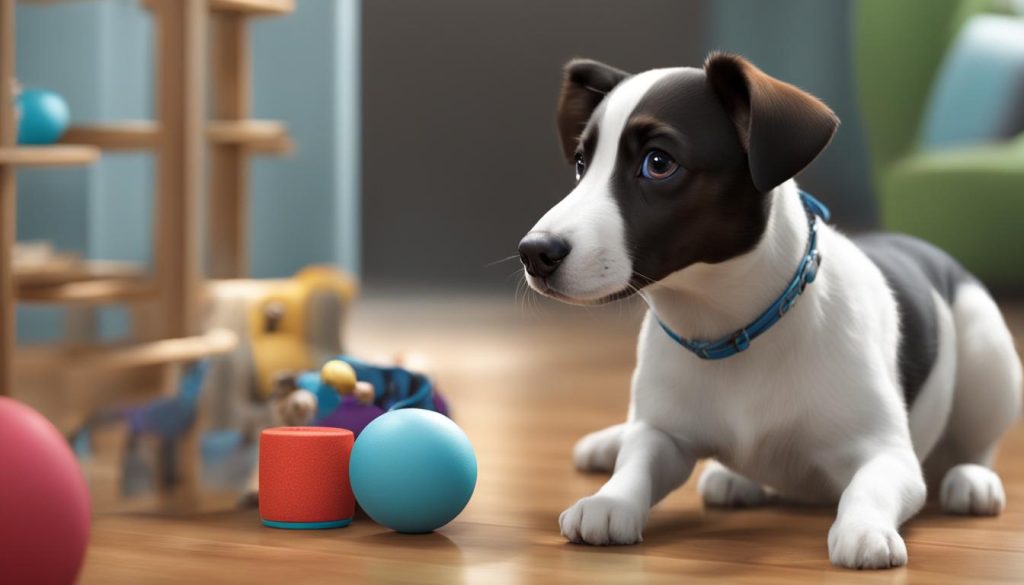
Advantages of Nose Touch Training for Dogs
Nose touch training has numerous advantages for dogs, offering both mental and behavioral benefits. By incorporating this training technique into your dog’s routine, you can enhance their obedience, communication, and overall training capabilities. Here are some key advantages of nose touch training:
- Enhanced Focus: Nose touch training helps dogs develop a strong focus and attention to detail. By teaching them to target their nose to specific objects or body positions, they learn to concentrate on the task at hand, improving their overall focus during training sessions.
- Improved Communication: Nose touch training enhances communication between dogs and their owners. By associating the touch command with specific behaviors, such as ringing a bell or greeting with a nose touch, dogs can effectively convey their needs and desires, creating a stronger bond and understanding with their owners.
- Calming Effect: For anxious or reactive dogs, nose touch training can provide a calming effect. By redirecting their attention to a target, such as touching an object or performing a specific behavior, dogs can shift their focus away from triggers that may cause anxiety or reactivity, promoting a calmer and more relaxed state of mind.
- Increased Mental Stimulation: Nose touch training adds mental stimulation to your dog’s daily routine. By introducing new objects for them to touch and learning more complex behaviors, dogs are challenged mentally, keeping their minds sharp and engaged.
| Advantages | Description |
|---|---|
| Enhanced Focus | Nose touch training helps dogs develop a strong focus and attention to detail. |
| Improved Communication | Nose touch training enhances communication between dogs and their owners. |
| Calming Effect | For anxious or reactive dogs, nose touch training can provide a calming effect. |
| Increased Mental Stimulation | Nose touch training adds mental stimulation to your dog’s daily routine. |
Overall, nose touch training is a valuable tool for teaching dogs various behaviors and enhancing their overall training experience. The advantages of nose touch training include improved focus, enhanced communication, a calming effect for anxious dogs, and increased mental stimulation. Incorporating nose touch into your dog’s training routine can lead to better obedience, increased cooperation, and a stronger bond between you and your furry friend.
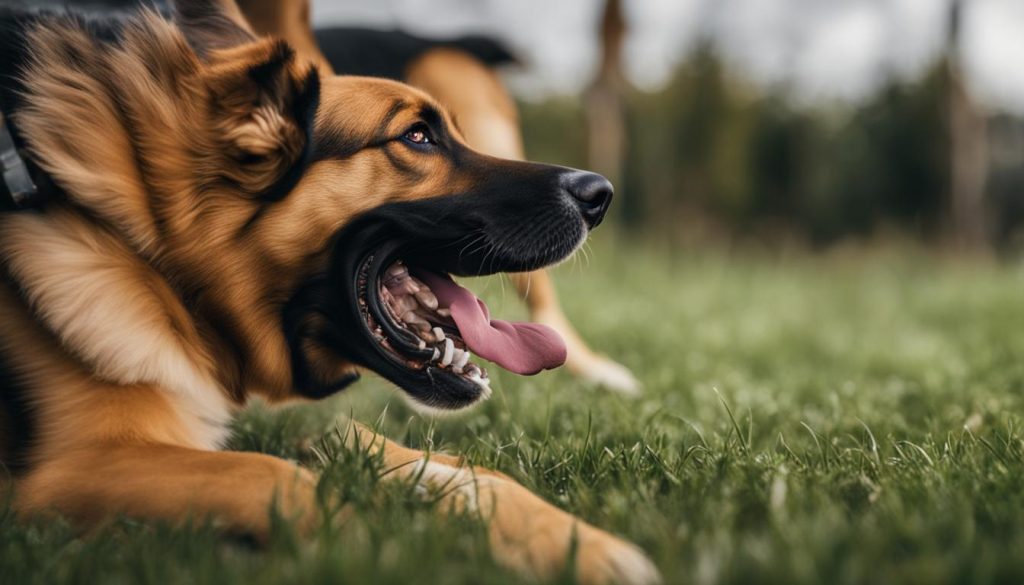
Trick Training with Nose Touching
Trick training with nose targeting is an exciting and engaging way to enhance your dog’s repertoire of tricks. By teaching your dog to perform various behaviors using a nose touch command, you can challenge their mental capabilities and strengthen the bond between you and your furry friend.
One popular trick that can be taught using nose touch training is spinning in a circle. To train this trick, you can use a target object, such as a small hoop or a round target mat. Hold the target in front of your dog and use the nose touch command to encourage them to touch the target. Reward them with a treat and praise when they successfully touch the target. Gradually reduce the size of the target until your dog can perform the trick without it.
Spinning in a circle can be a fun and entertaining trick for both you and your dog. It showcases your dog’s ability to follow commands and adds a touch of flair to their trick repertoire. Try to be patient and consistent in your training, rewarding your dog for their efforts and progress along the way.
Another trick that can be taught using nose touch training is flipping a light switch. This trick requires a target object, such as a small wooden dowel or a switch-shaped toy. Begin by holding the target object next to the light switch and using the nose touch command to encourage your dog to touch the target. Reward them with a treat and praise each time they successfully touch the target. Gradually move the target closer to the light switch until your dog can reach the switch with their nose.
Trick training with nose targeting allows you to tap into your dog’s natural instincts and abilities while providing them with mental stimulation and a sense of accomplishment. You should break down each trick into smaller steps, reward your dog’s progress, and have patience throughout the training process. With consistent practice and positive reinforcement, you and your dog can master a variety of impressive tricks using nose touch training.
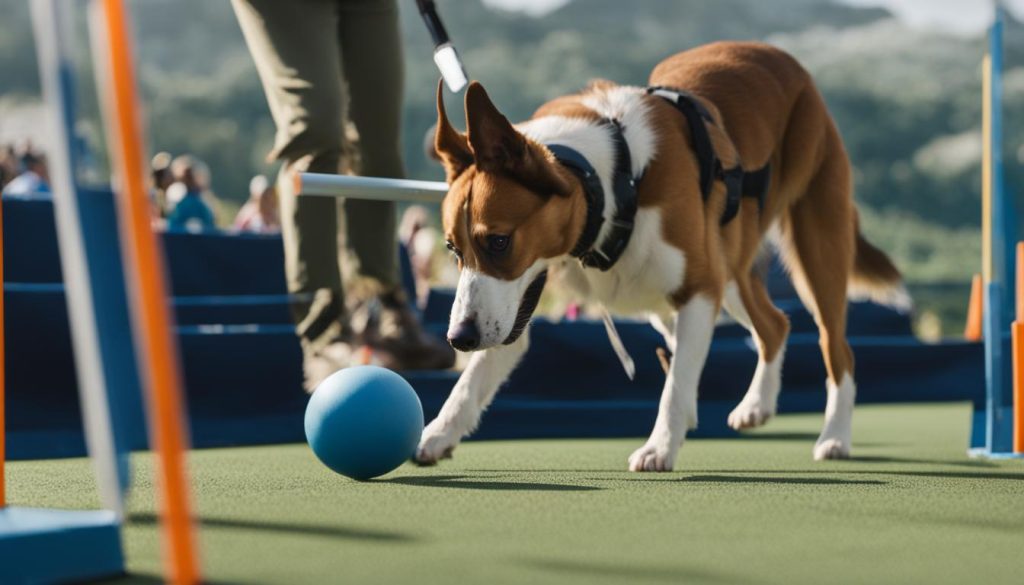
Trick Training Tips:
- Start with simple tricks and gradually increase the level of difficulty.
- Use high-value treats and plenty of praise to motivate your dog.
- Break down each trick into small steps and reward your dog’s progress.
- Practice in short training sessions to keep your dog engaged and focused.
- Be patient and have fun with the training process!
To put it simply, trick training is not only a great way to entertain and impress others, but it also provides mental stimulation and builds a strong bond with your dog. Enjoy exploring the possibilities of trick training with nose targeting and unleash your dog’s hidden talents.
Using Nose Touching for Anxious or Reactive Dogs
Nose touch training can be a valuable tool for managing and alleviating anxiety or reactivity in dogs. By redirecting their attention to a target, such as your hand or an object, you can provide them with a positive and engaging focus that helps reduce stress and promote a calmer state of mind. This technique offers several benefits for anxious or reactive dogs.
1. Distraction and Redirected Focus: Nose touch training provides a distraction from triggers that may cause anxiety or reactivity in dogs. By teaching your dog to touch a target with their nose, you can redirect their attention away from potential stressors and towards a positive and rewarding behavior.
2. Alternative Behavior: Nose touch training gives anxious or reactive dogs an alternative behavior to engage in when faced with challenging situations. Instead of reacting anxiously or aggressively, they can focus on the target and perform the nose touch command, which can help them feel more in control and reduce their reactive responses.
3. Mental Stimulation and Engagement: Nose touch training provides mental stimulation for dogs, which can be helpful in diverting their attention from anxiety or triggers. It engages their cognitive abilities and offers a mentally enriching activity that promotes focus and concentration.
Testimonials
“Nose touch training has been a game-changer for my anxious dog. It has helped redirect his attention during stressful situations and has given him a clear and positive behavior to focus on. I can see a noticeable improvement in his overall anxiety levels.” – Sarah, dog owner
Incorporating nose touch training into your dog’s routine can be beneficial for managing anxiety or reactivity. By providing a distraction, promoting alternative behaviors, and offering mental stimulation, nose touch training can help anxious or reactive dogs cope with challenging situations in a more positive and controlled manner.
Step-by-Step Guide for Teaching Nose Touching
Teaching your dog nose touch can be a rewarding and beneficial training technique. Follow this step-by-step guide to effectively teach your dog the nose touch command:
1. Introduce the Behavior
Begin by holding your flat hand a few inches away from your dog’s nose. When their nose makes contact with your hand, use a clicker or a marker word, like “Yes,” and reward them with a treat. Repeat this process until your dog reliably touches your hand with their nose.
2. Establish a Reliable Touch Command
Once your dog is consistently touching your hand, it’s time to add a verbal cue. Choose a command like “Touch” and say it just before presenting your hand as the target. This will help your dog associate the command with the behavior. Continue practicing until your dog responds to the verbal cue without hesitation.
3. Expand to Objects
Once your dog understands the touch command, you can introduce other objects for them to touch. Start with small, easily accessible items like a yogurt lid or a piece of clear plastic. Hold the object in your hand and ask your dog to touch it. Gradually remove your hand from the equation, allowing your dog to touch the object directly.
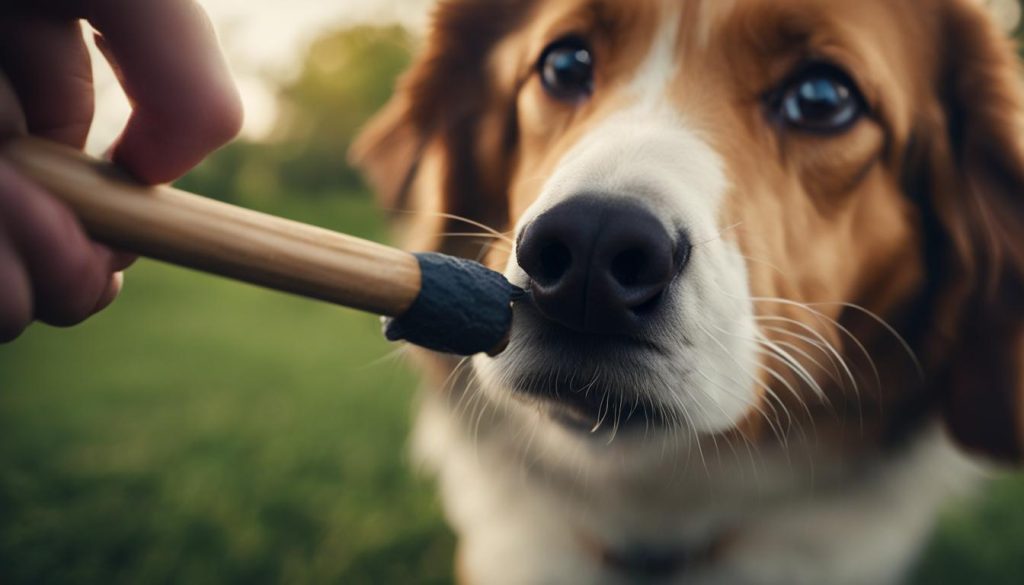
4. Incorporate Nose Touch into Training
Take advantage of the nose touch command in obedience training. Use it to teach your dog body positions, such as sitting from a standing position or standing from a sitting position. You can also use the touch command to teach your dog to ring a bell or greet people with a nose touch instead of jumping on them.
In trick training, the nose touch command opens up a world of possibilities. You can teach your dog tricks like spinning in a circle or flipping a light switch using a target object. The ultimate goal is to have your dog perform the trick without the target, relying solely on the nose touch command.
By following this step-by-step guide, you can successfully teach your dog nose touch and strengthen your bond through effective training techniques.
Final Thoughts
To sum it up, nose touch training is a valuable skill for teaching dogs various behaviors. By following a step-by-step guide and using positive reinforcement techniques, you can effectively teach your dog nose touch and enhance their training capabilities.
Nose touch training provides mental stimulation and improves communication between dogs and their owners. It can also be particularly beneficial for anxious or reactive dogs, helping to redirect their attention and promote a calmer state of mind.
Additionally, nose touch training can be expanded to include obedience and trick training, offering a range of possibilities for teaching body positions, good manners, and engaging tricks.
Start incorporating nose touch into your training routine and witness the growth of your dog’s skills and the strengthening of your bond.
FAQ
What is nose targeting or nose touch training?
Nose targeting, also known as “Touch,” is a valuable skill for training dogs. It involves teaching your dog to touch a target with their nose, which can be used for various training purposes.
How do I teach my dog nose touch?
Start by using your flat hand as the target. Hold your hand a few inches away from your dog and click or use a marker word when their nose makes contact with your hand. Repeat this process until your dog consistently touches your hand with their nose. Then, you can add a verbal cue like “Touch” to associate the behavior with a command. Gradually increase the distance, add distractions, and introduce objects for your dog to touch.
How can I make nose touch training successful?
Use exciting treats and provide plenty of praise to reward your dog’s nose bumps. Ignore tentative touches and reward the most enthusiastic ones to build enthusiasm. If your dog is struggling, you can rub your hand with a smelly treat to entice them. Shape the behavior by rewarding small steps towards the target and gradually increasing criteria. Consistency and positive reinforcement will help your dog master nose touch training.
Can nose touch training be transferred to other objects?
Yes, once your dog is reliably touching your hand, you can transfer the behavior to other objects like a yogurt lid or a piece of clear plastic. Hold the object in your hand and ask your dog to touch it. Gradually move the object off your hand until your dog is touching the object directly. Practice with different objects and gradually add distance and distractions to help your dog generalize the nose touch command to various situations.
How can nose targeting be used in obedience training?
Nose targeting can be used in obedience training to teach body positions and good manners. For example, you can ask your dog to stand from a sitting position by using a touch command. You can also use touch to teach your dog to ring a bell to signal their desire to go outside or to greet people with a nose touch instead of jumping on them. Nose touch training enhances communication and cooperation between dogs and their owners.
Is nose touch training useful for trick training?
Yes, nose targeting can be used for trick training. You can teach your dog tricks like spinning in a circle or flipping a light switch by using a target object. The ultimate goal is to have your dog perform the trick without the target, relying solely on the nose touch command. This adds mental stimulation and challenge to your dog’s repertoire of tricks.
Can nose touch training help anxious or reactive dogs?
Yes, nose touch training can be particularly helpful for anxious or reactive dogs. By redirecting their attention to a target, you can help them focus on something positive and reduce their anxiety or reactivity. Nose touch training provides a distraction and gives them an alternative behavior to engage in. It can be used to redirect their attention away from triggers and promote a calmer and more focused state of mind.
What is a step-by-step guide for teaching nose touch to my dog?
A step-by-step guide for teaching nose touch involves introducing the behavior with your hand as the target, establishing a reliable touch command, expanding to objects, and incorporating nose touch into obedience and trick training. Following this guide will help you effectively teach your dog nose touch and reap the benefits of this valuable training technique.


